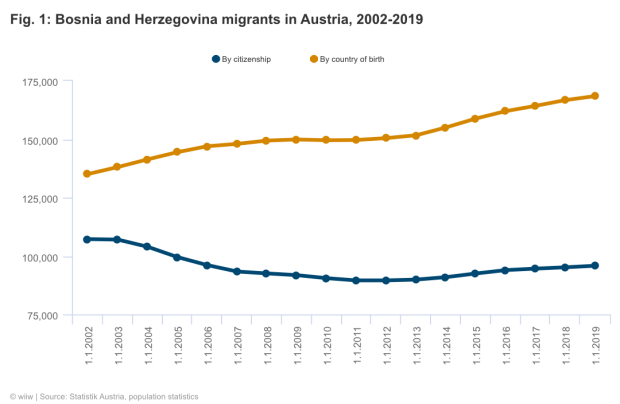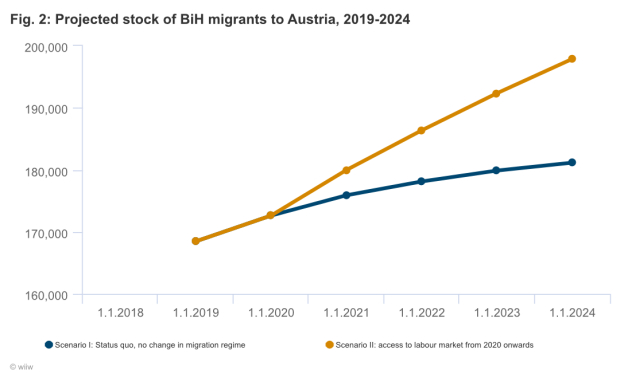The future of migration from Bosnia and Herzegovina to Austria
17 December 2019
Big wage differentials, existing migration networks and labour shortages in Austria will continue to encourage migration flows from Bosnia and Herzegovina to Austria.
By Isilda Mara, Marko Martic and Ognjen Djukic.
photo: iStock.com/mirsad sarajlic
- Bosnia and Herzegovina (BiH) is the leading Western Balkan country in terms of emigration, in both absolute and relative terms. Austria hosts about 10% of all BiH emigrants which accounts for 1.9% of the current Austrian population.
- The strong labour migration flows from BiH to Austria are expected to continue, fuelled by the big differences in wages and in the level of unemployment between the two countries, coupled with their geographical proximity, the visa-free regime and the existence of substantial social networks of BiH citizens in Austria.
- Between 13 and 29 thousand BiH migrants – corresponding to 0.14% and 0.33% of the Austrian population, respectively - are expected to arrive to Austria by 2024.
- The research underlines the dual impact of migration on labour markets in sending and receiving countries, such as BiH and Austria.
There is a relatively long history of migration between Bosnia and Herzegovina (BiH) and Austria. It started in the 1970s, when the country was still part of former Yugoslavia; was followed by refugee flows in 1990s; and then latterly by labour-related movements. Over the last five years migration flows from BiH to Austria rose by 8.6%, and the stock of BiH migrants in Austria (define by country of birth rather than citizenship) reached 168,500 in 2019.
Expected trends
The trends have prompted stakeholders from both countries to seek more information about the prospects of migration flows and the potential implications for labour markets. In particular, they have sparked public debate in BiH about future emigration trends and their anticipated impact on the country’s domestic labour market, external competitiveness and economic activity.
This research aims at predicting the future medium-term mobility of migrants from BiH to Austria (for January 2019 to January 2024). The estimation has been made by applying a macro-gravity model, which has already performed quite well in predicting the migration potential of Romanians and Bulgarians to Austria after the opening up of the labour market in 2013. The approach takes account of the fact that future mobility will be affected by macroeconomic determinants, such as earnings and employment opportunities at home and in the host countries; geographical and cultural proximity; and institutional features (e.g. labour-mobility constraints) that might differ from country to country.
The results suggest that migration flows from BiH to Austria will remain strong, or even increase in intensity. According to the first scenario (status quo in the institutional arrangements for BiH migrants applied by Austria and other destination countries), the stock of BiH migrants in Austria would increase by 12,700 over the next five years. According to the second scenario (Austria and other destination countries provide additional access to the labour markets for BiH migrants), the projected stock will increase by 29,400. These expected net flows of BiH migrants to Austria correspond to about 0.14% and 0.33%, respectively, of the current Austrian population.
Potential implications for labour markets in Austria and BiH
In BiH, the workforce outflow due to emigration has contributed to a tightening of the country’s labour market, which has been reflected in a decrease in the unemployment rate and an increase in average wages. Interestingly, in terms of their educational profile, BiH migrants to Austria have a lower skills level than BiH migrants generally – and even than the BiH population. Accordingly, this particular migration flow could affect the wages of low-skilled workers in BiH positively, by reducing their labour supply. The other side of the migration coin is a risk of population decrease, leading to a further tightening of the labour market. The BiH labour market is already faced with skills shortages that could severely affect the country’s economic growth over the next five years. From a long-term perspective, it is of the utmost importance that Bosnia and Herzegovina should create an overall socio-economic environment that encourages potential emigrants to stay – and that generates some return migration. In order to mitigate the negative effects of current emigration trends, prompt responses are needed – primarily through better use being made of the remaining workforce. Specifically, interventions on the supply side of the labour market through education and vocational training for the unemployed in line with employers’ needs, as well as through activation for those who are inactive (especially women), should offset the negative effects of the shrinkage of the labour market.
As for Austria there seems to be a positive impact of labour inflows particularly in occupations with acute labour shortages. The BiH migrants account for 9.7% of Austria’s total stock of migrants. Even though these are relatively poorly qualified – only 5% are highly skilled – there are indications that BiH migrants are still employed in jobs that are below their skill levels. This implies that the primary purpose of BiH migrants in Austria has been to alleviate labour shortages in low-skilled jobs. Further, employed workers from BiH are mostly concentrated in economic sectors with high vacancy rates, suggesting that demand for similar profiles of workers on Austria’s labour market will remain high in the coming period.
This joint research, conducted by the Vienna Institute for International Economic Studies (wiiw) in Austria and GEA – Center for Research and Studies in Bosnia and Herzegovina, can be downloaded using this link.


